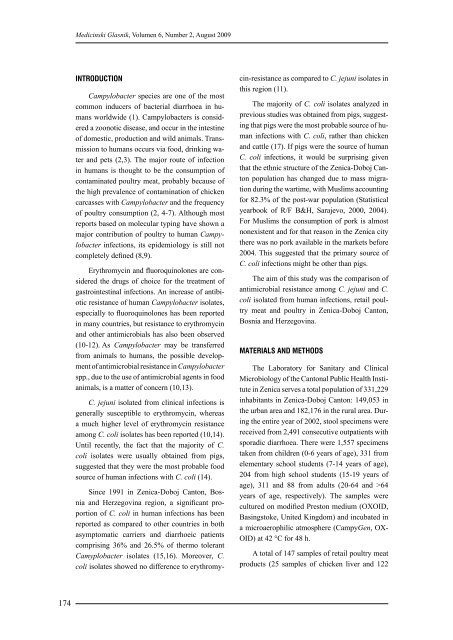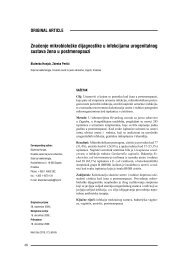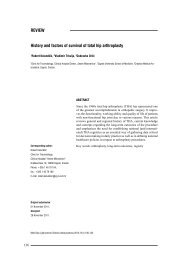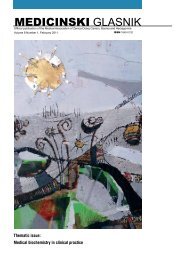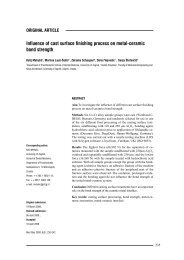MEDICINSKI GLASNIK
MEDICINSKI GLASNIK
MEDICINSKI GLASNIK
Create successful ePaper yourself
Turn your PDF publications into a flip-book with our unique Google optimized e-Paper software.
174<br />
Medicinski Glasnik, Volumen 6, Number 2, August 2009<br />
INTRODUCTION<br />
Campylobacter species are one of the most<br />
common inducers of bacterial diarrhoea in humans<br />
worldwide (1). Campylobacters is considered<br />
a zoonotic disease, and occur in the intestine<br />
of domestic, production and wild animals. Transmission<br />
to humans occurs via food, drinking water<br />
and pets (2,3). The major route of infection<br />
in humans is thought to be the consumption of<br />
contaminated poultry meat, probably because of<br />
the high prevalence of contamination of chicken<br />
carcasses with Campylobacter and the frequency<br />
of poultry consumption (2, 4-7). Although most<br />
reports based on molecular typing have shown a<br />
major contribution of poultry to human Campylobacter<br />
infections, its epidemiology is still not<br />
completely defined (8,9).<br />
Erythromycin and fluoroquinolones are considered<br />
the drugs of choice for the treatment of<br />
gastrointestinal infections. An increase of antibiotic<br />
resistance of human Campylobacter isolates,<br />
especially to fluoroquinolones has been reported<br />
in many countries, but resistance to erythromycin<br />
and other antimicrobials has also been observed<br />
(10-12). As Campylobacter may be transferred<br />
from animals to humans, the possible development<br />
of antimicrobial resistance in Campylobacter<br />
spp., due to the use of antimicrobial agents in food<br />
animals, is a matter of concern (10,13).<br />
C. jejuni isolated from clinical infections is<br />
generally susceptible to erythromycin, whereas<br />
a much higher level of erythromycin resistance<br />
among C. coli isolates has been reported (10,14).<br />
Until recently, the fact that the majority of C.<br />
coli isolates were usually obtained from pigs,<br />
suggested that they were the most probable food<br />
source of human infections with C. coli (14).<br />
Since 1991 in Zenica-Doboj Canton, Bosnia<br />
and Herzegovina region, a significant proportion<br />
of C. coli in human infections has been<br />
reported as compared to other countries in both<br />
asymptomatic carriers and diarrhoeic patients<br />
comprising 36% and 26.5% of thermo tolerant<br />
Camyplobacter isolates (15,16). Moreover, C.<br />
coli isolates showed no difference to erythromy-<br />
cin-resistance as compared to C. jejuni isolates in<br />
this region (11).<br />
The majority of C. coli isolates analyzed in<br />
previous studies was obtained from pigs, suggesting<br />
that pigs were the most probable source of human<br />
infections with C. coli, rather than chicken<br />
and cattle (17). If pigs were the source of human<br />
C. coli infections, it would be surprising given<br />
that the ethnic structure of the Zenica-Doboj Canton<br />
population has changed due to mass migration<br />
during the wartime, with Muslims accounting<br />
for 82.3% of the post-war population (Statistical<br />
yearbook of R/F B&H, Sarajevo, 2000, 2004).<br />
For Muslims the consumption of pork is almost<br />
nonexistent and for that reason in the Zenica city<br />
there was no pork available in the markets before<br />
2004. This suggested that the primary source of<br />
C. coli infections might be other than pigs.<br />
The aim of this study was the comparison of<br />
antimicrobial resistance among C. jejuni and C.<br />
coli isolated from human infections, retail poultry<br />
meat and poultry in Zenica-Doboj Canton,<br />
Bosnia and Herzegovina.<br />
MATERIALS AND METHODS<br />
The Laboratory for Sanitary and Clinical<br />
Microbiology of the Cantonal Public Health Institute<br />
in Zenica serves a total population of 331,229<br />
inhabitants in Zenica-Doboj Canton: 149,053 in<br />
the urban area and 182,176 in the rural area. During<br />
the entire year of 2002, stool specimens were<br />
received from 2,491 consecutive outpatients with<br />
sporadic diarrhoea. There were 1,557 specimens<br />
taken from children (0-6 years of age), 331 from<br />
elementary school students (7-14 years of age),<br />
204 from high school students (15-19 years of<br />
age), 311 and 88 from adults (20-64 and >64<br />
years of age, respectively). The samples were<br />
cultured on modified Preston medium (OXOID,<br />
Basingstoke, United Kingdom) and incubated in<br />
a microaerophilic atmosphere (CampyGen, OX-<br />
OID) at 42 °C for 48 h.<br />
A total of 147 samples of retail poultry meat<br />
products (25 samples of chicken liver and 122


